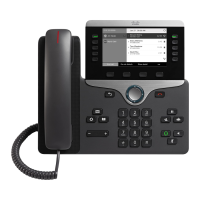If you want the user to be able to select your image from various wallpapers available on the phone, then
modify the List file. But if you want to push the image to the phone, then create or modify an existing Common
Phone Profile.
For more information on customizing wallpaper, see the "Custom Phone Rings and Backgrounds" chapter,
Feature Configuration Guide for Cisco Unified Communications Manager.
Regardless of your approach, note the following:
•
Your images must be in PNG format and the dimensions of the full sized image must be within 800
pixels by 480 pixels. Thumbnail images are 25 per cent of the full sized image.
•
Upload the images and List file to your TFTP server. The directory is Desktops/800x400. Restart the
server after the upload is done.
•
If you modify your Common Phone Profile, then add the new image to the Background Image field in
the format mylogo.png. If you don't want the user selecting their own wallpaper, then uncheck Enable
End User Access to Phone Background Image Setting. Save and apply the phone profile. Restart the
phones so your changes take effect.
For more information on selecting the wallpaper on the phone, see the "Settings" chapter in the Cisco IP
Phone 8800 Series User Guide.
Set Up Wideband Codec
By default, the G.722 codec is enabled for the Cisco IP Phone. If Cisco Unified Communications Manager
is configured to use G.722 and if the far endpoint supports G.722, the call connects using the G.722 codec in
place of G.711.
This situation occurs regardless of whether the user has enabled a wideband headset or wideband handset,
but if either the headset or handset is enabled, the user may notice greater audio sensitivity during the call.
Greater sensitivity means improved audio clarity but also means that the far endpoint can hear more background
noise: noise such as rustling papers or nearby conversations. Even without a wideband headset or handset,
some users may prefer the additional sensitivity of G.722 distracting. Other users may prefer the additional
sensitivity of G.722.
The Advertise G.722 and iSAC Codec service parameter affects whether wideband support exists for all
devices that register with this Cisco Unified Communications Manager server or for a specific phone, depending
on the Cisco Unified Communications Manager Administration window where the parameter is configured.
Procedure
Step 1
To configure wideband support for all devices:
a) From Cisco Unified Communications Manager Administration, choose System > Enterprise Parameters
b) Set the Advertise G.722 and iSAC Codec field
The default value of this enterprise parameter is True, which means that all Cisco IP Phone Models that
register to this Cisco Unified Communications Manager advertise G.722 to Cisco Unified Communications
Manager. If each endpoint in the attempted call supports G.722 in the capabilities set, Cisco Unified
Communications Manager chooses that codec for the call whenever possible.
Step 2
To configure wideband support for a specific device:
a) From Cisco Unified Communications Manager Administration, choose Device > Phone.
Cisco IP Phone 8800 Series Administration Guide for Cisco Unified Communications Manager
114
Set Up Wideband Codec

